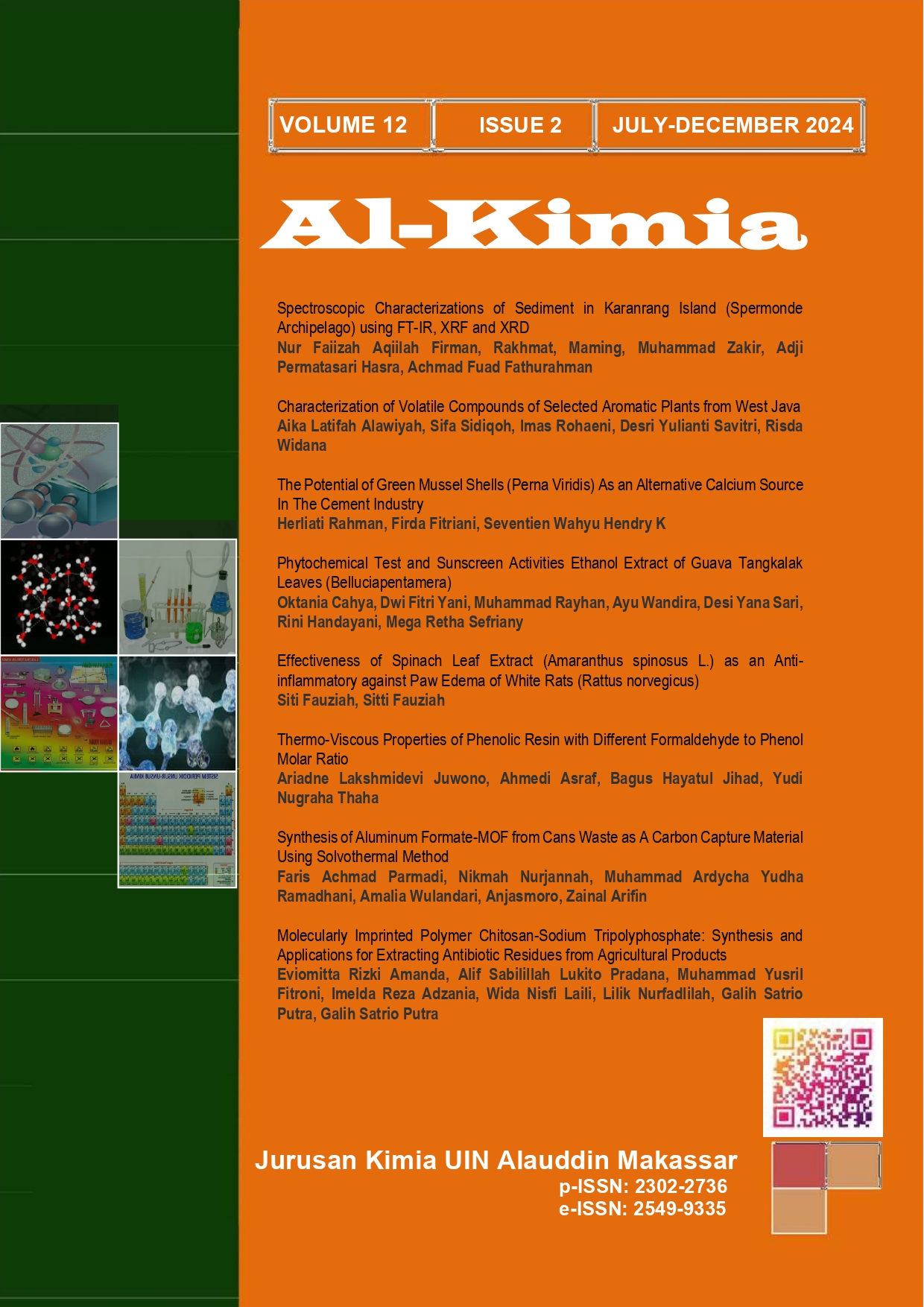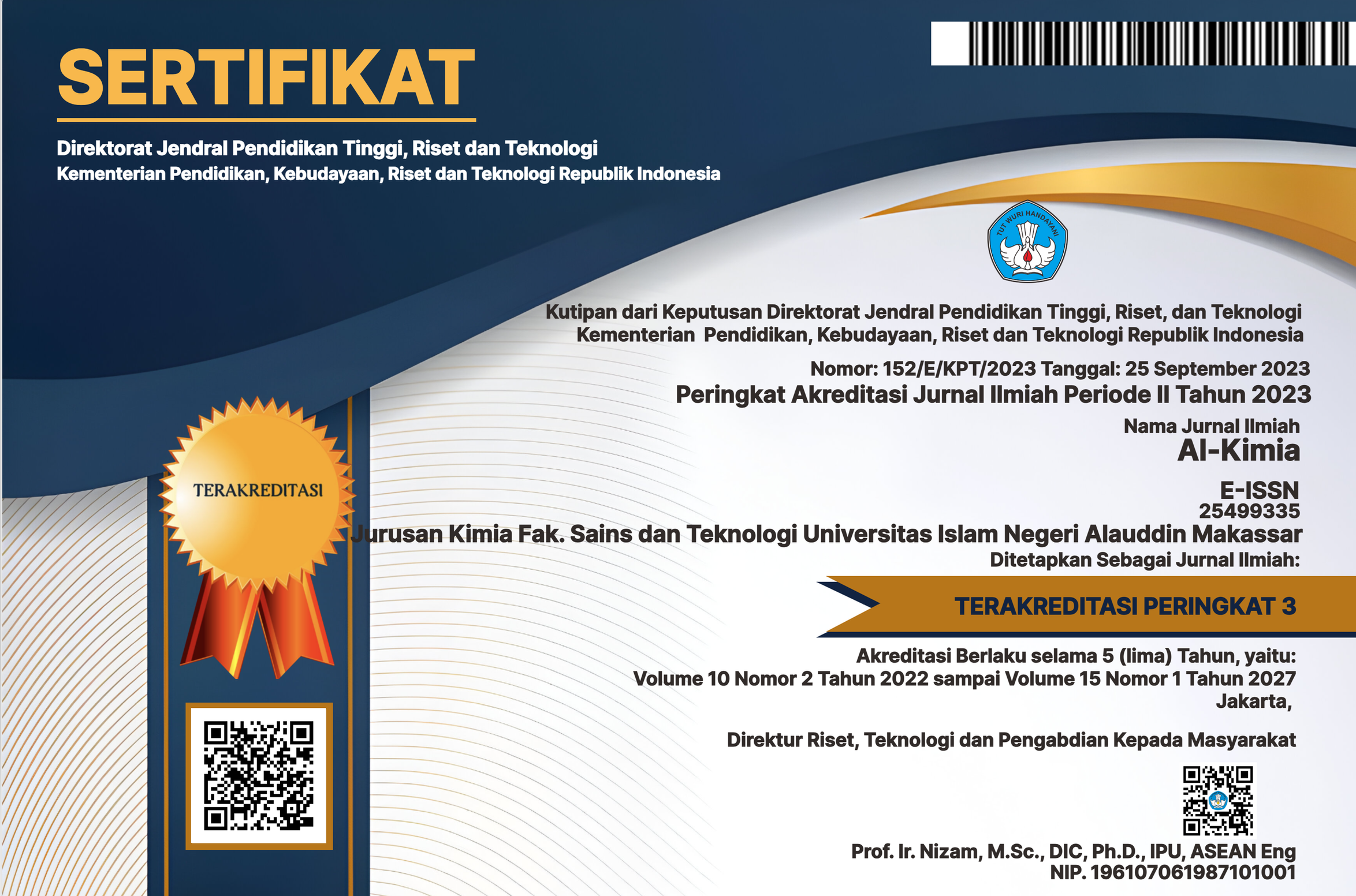Characterization of Volatile Compounds of Selected Aromatic Plants from West Java
DOI:
https://doi.org/10.24252/al-kimia.v12i2.47840Keywords:
aromatic plant, essential oils, limonene, patchouli alcohol, valerenalAbstract
Chrysopogon zizanioides (Poaceae), Pogostemon cablin (Lamiaceae), Cymbopogon nardus (Poaceae) and Citrus reticulate (Rutaceae) are known for their abundant essential oils and major commodities in Garut, West Java. Understanding the chemical composition of organic compounds can provide insights into the complex mixture of organic compounds contributing in plants' odour, flavour, and potency. This study aimed to identify the chemical composition of the essential oils of C. zizanioides (roots), P. cabin (leaves), C. nardus (stems), and C. reticulate (leaves and peel). The essential oils were distilled using the hydro distillation method. The chemical composition of essential oils was analyzed by Gas Chromatography-Massa Spectrometry (GC-MS). The results showed that the dominant significant compounds in the essential oil of C. zizanioides roots included valerenal (14.81%). Patchouli alcohol (33.23%) and E-citral (36.18%) were found in P. cabin leaves and C. nardus stems, respectively. The essential oil of C. reticulate leaves and peel contained significant compounds, namely limonene, with a percentage of 30.98% for leaves and 82.58% for peel. Sesquiterpenes were the dominant compounds found in C. zizanioides root and P. cabin leaves oil, while monoterpenes were the major compounds in C. nardus stem, C. reticulate leaves and peel.
Downloads
References
Abram, P., Putri, W., Nuryanti, S., & Sabang, S. (2021). Characterization of patchouli oil (Pogostemon cablin Benth) production of Tinombala Village , Ongka Malino District , Parigi Moutong Regency. Journal of Physics: Conference Series, 1–12. https://doi.org/10.1088/1742-6596/2126/1/012024
Achmad, H. N., Rana, H. E., Manurung, R., & Abduh, M. Y. (2018). Determination of Yield and Chemical Composition of Eucalyptus Oil from Different Species And Locations in Indonesia. Biological and Natural Resources Engineering Journal, 01(01), 36–49.
Ahmad Kamal, H. Z., Tuan Ismail, T. N. N., Arief, E. M., & Ponnuraj, K. T. (2020). Antimicrobial activities of citronella (Cymbopogon nardus) essential oil against several oral pathogens and its volatile compounds. Padjadjaran Journal of Dentistry, 32(1), 1. https://doi.org/10.24198/pjd.vol32no1.24966
Ahmed, H., & Claudio, A. G. (2017). Chemical composition and bioactivity of peel oils from Citrus aurantiifolia and Citrus reticulata and enantiomers of their major constituent against Sitophilus zeamais ( Coleoptera : Curculionidae ). Journal of Stored Products Research, 73, 30–36. https://doi.org/10.1016/j.jspr.2017.06.001
Albuquerque, E. L. D., Lima, J. K. A., Souza, F. H. O., Silva, I. M. A., Santos, A. A., Araújo, A. P. A., Blank, A. F., Lima, R. N., Alves, P. B., & Bacci, L. (2013). Insecticidal and Repellence Activity of The Essential Oil of Pogostemon cablin against Urban Ants Species. Acta Tropica, 127(3), 181–186. https://doi.org/10.1016/j.actatropica.2013.04.011
Downloads
Published
Versions
- 2025-06-21 (2)
- 2024-12-22 (1)
How to Cite
Issue
Section
License
Authors who publish with this journal agree to the following terms:
1) Authors retain copyright and grant the journal right of first publication with the work simultaneously licensed under a Creative Commons Attribution License that allows others to share the work with an acknowledgement of the work's authorship and initial publication in this journal.
2) Authors are able to enter into separate, additional contractual arrangements for the non-exclusive distribution of the journal's published version of the work (e.g., post it to an institutional repository or publish it in a book), with an acknowledgement of its initial publication in this journal.
3)Authors are permitted and encouraged to post their work online (e.g., in institutional repositories or on their website) prior to and during the submission process, as it can lead to productive exchanges, as well as earlier and greater citation of published work (See The Effect of Open Access).



